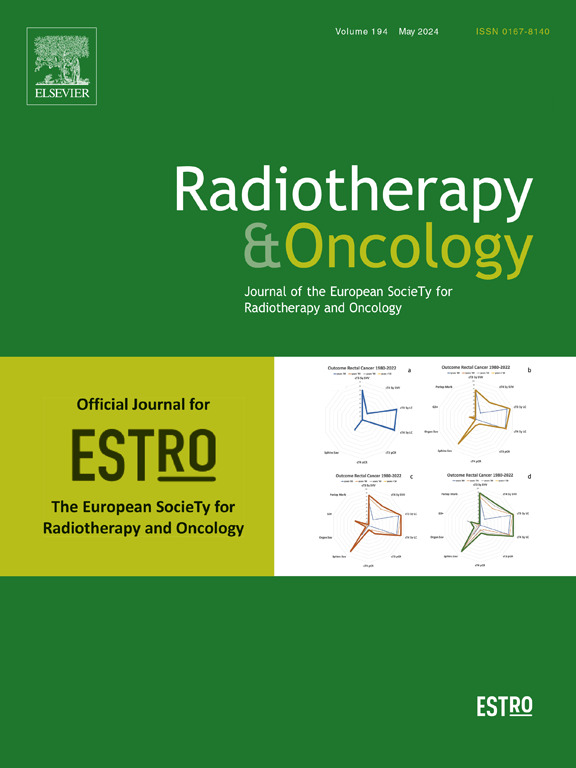Automated vertebral identification and localization for enhanced radiotherapy patient setup
IF 4.9
1区 医学
Q1 ONCOLOGY
引用次数: 0
Abstract
Background and purpose
Vertebral bodies are critical landmarks for image-based patient positioning during radiotherapy (RT). However, manual identification of vertebral bodies can be laborious and a source of error, potentially leading to treatment mistakes. This study demonstrated an automated technique for vertebral identification and localization in images with varying quality and field of view (FOV), aiming to streamline the positioning process and minimize the risk of patient misalignment.
Materials and methods
This retrospective study employed an nnU-Net-based model for automated vertebral identification and localization. Training was performed on 1,053 datasets (993 public datasets: SpineWeb, Verse19, Verse20, Spine1K; 60 clinical on-board CT scans from Infinity® and TomoTherapy®). Testing included 688 public datasets, 155 clinical on-board CT scans (Ethos®, Infinity®, TomoTherapy®, TrueBeam®, Trilogy®), and 50 clinical planning CTs (Brilliance CT Big-Bore-Oncology®). A strategic four-step post-processing procedure was developed to enhance accuracy, considering the anatomical characteristics of vertebral structures and vertebral abnormalities. Evaluation metrics included identification rates, mean localization errors, and their standard deviations.
Results
The method achieved high identification rates of 97.99 % with a mean localization error of 1.64 ± 1.23 mm on public datasets and 99.76 % with a mean error of 1.74 ± 1.36 mm on clinical datasets. Refining traditional 20 mm accuracy thresholds, new section-specific thresholds were established 10 mm for cervical, 15 mm for thoracic, and 19 mm for lumbar vertebrae.
Conclusions
This automated approach offers an accurate and widely applicable model for vertebral identification and localization. It has the potential to enhance RT setup workflows and serve as a valuable clinical tool.
自动椎体识别和定位增强放疗患者设置
背景与目的在放射治疗(RT)中,椎体是基于图像的患者定位的关键标志。然而,人工鉴定椎体可能是费力的和错误的来源,潜在地导致治疗错误。本研究展示了一种在不同质量和视场(FOV)图像中进行椎体识别和定位的自动化技术,旨在简化定位过程并最大限度地降低患者错位的风险。材料和方法本回顾性研究采用基于神经网络的模型进行自动椎体识别和定位。在1053个数据集上进行了训练(993个公共数据集:SpineWeb、Verse19、Verse20、Spine1K;来自Infinity®和TomoTherapy®的60张临床机载CT扫描。测试包括688个公共数据集,155个临床车载CT扫描(Ethos®,Infinity®,TomoTherapy®,TrueBeam®,Trilogy®)和50个临床规划CT (Brilliance CT Big-Bore-Oncology®)。考虑到椎体结构和椎体异常的解剖特征,开发了一种战略性的四步后处理程序以提高准确性。评估指标包括识别率、平均定位误差及其标准差。结果该方法在公共数据集的识别率为97.99%,平均定位误差为1.64±1.23 mm;在临床数据集的识别率为99.76%,平均定位误差为1.74±1.36 mm。在传统的20毫米精度阈值的基础上,建立了新的特定部位阈值,分别为颈椎10毫米、胸椎15毫米和腰椎19毫米。结论该方法为椎体识别和定位提供了一种准确且广泛适用的模型。它有可能增强RT设置工作流程,并作为一种有价值的临床工具。
本文章由计算机程序翻译,如有差异,请以英文原文为准。
求助全文
约1分钟内获得全文
求助全文
来源期刊

Radiotherapy and Oncology
医学-核医学
CiteScore
10.30
自引率
10.50%
发文量
2445
审稿时长
45 days
期刊介绍:
Radiotherapy and Oncology publishes papers describing original research as well as review articles. It covers areas of interest relating to radiation oncology. This includes: clinical radiotherapy, combined modality treatment, translational studies, epidemiological outcomes, imaging, dosimetry, and radiation therapy planning, experimental work in radiobiology, chemobiology, hyperthermia and tumour biology, as well as data science in radiation oncology and physics aspects relevant to oncology.Papers on more general aspects of interest to the radiation oncologist including chemotherapy, surgery and immunology are also published.
 求助内容:
求助内容: 应助结果提醒方式:
应助结果提醒方式:


